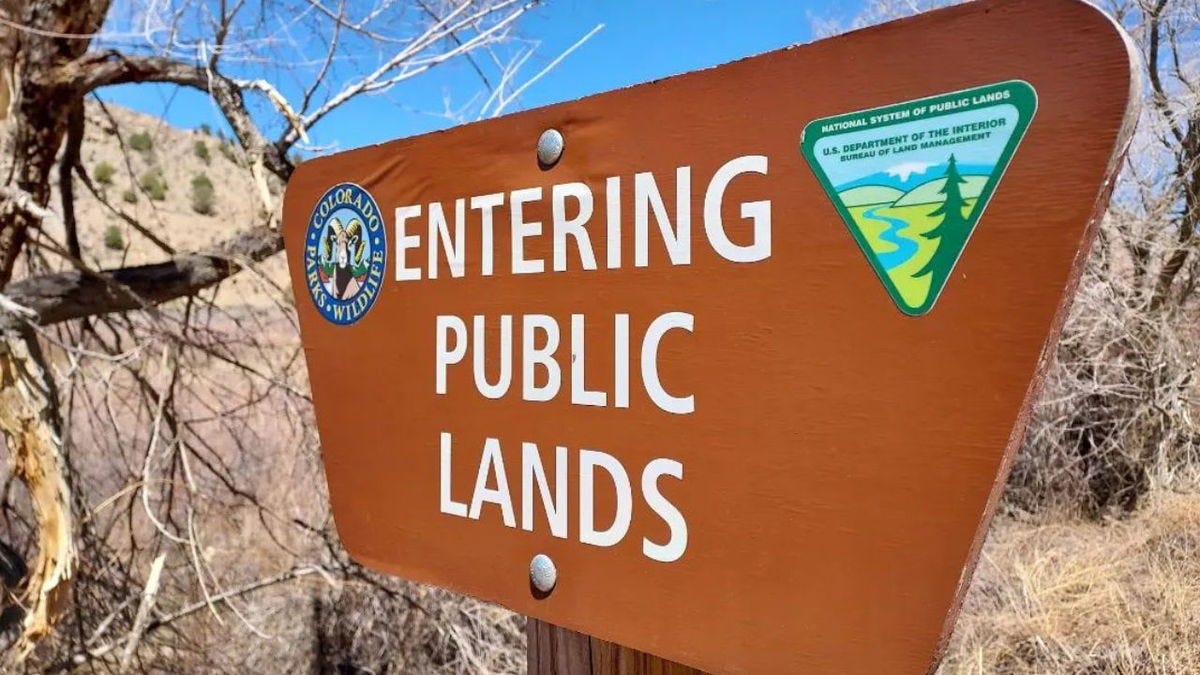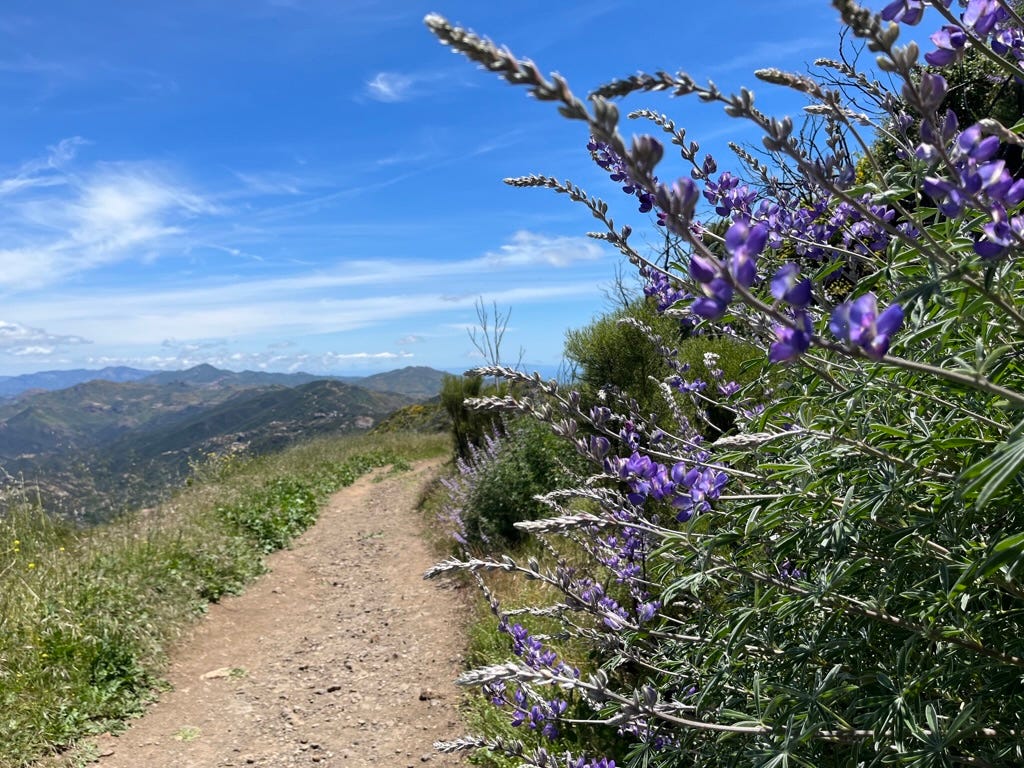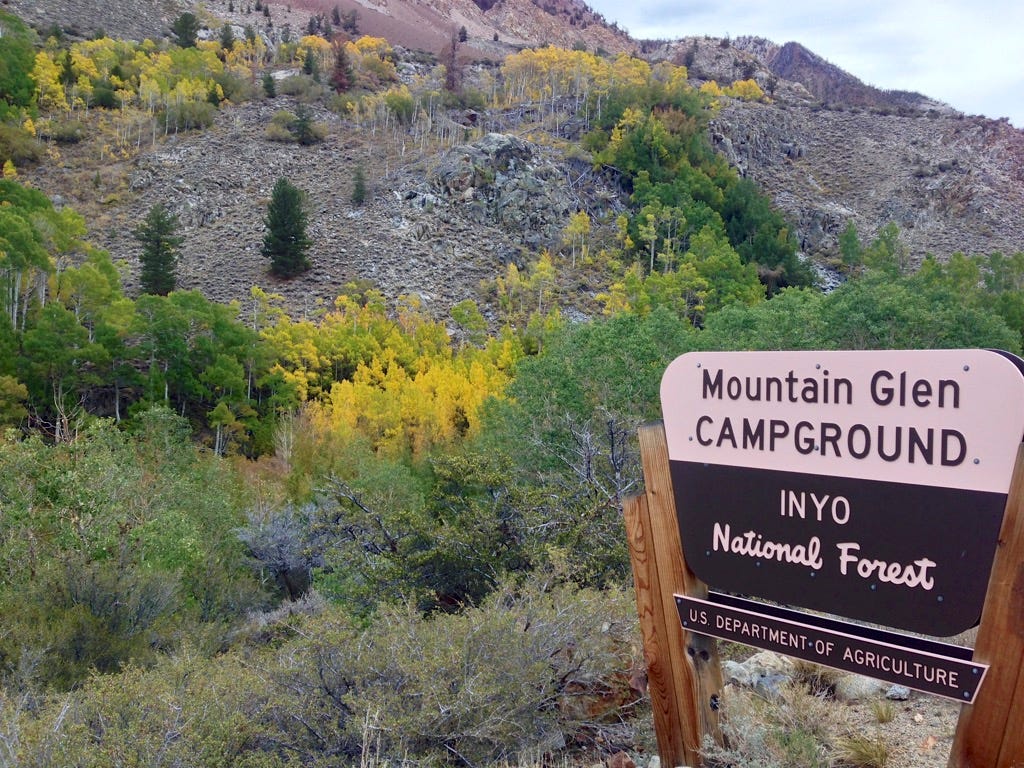A Ping from the Void
Plus, how we talk about public lands, winter forecasts, keeping a trail open, and the best foliage tracker in the West
howdy
Um … hello?
Yeah, it’s been … a while. It’s been so long that a reader reached out to me via email to ask if I was OK, which I really appreciate and also, because I was raised Catholic in New England, feel so guilty about.
So … the good news is, I’m fine! Everything is good over here, and in many ways it’s great, although I am putting a lot of thought into what the future holds on a lot of fronts. First, some personal news: in the past several weeks, I’ve had some work transitions that I’ve had to navigate—I’m still employed, but I got bumped around to a new team in the midst of some layoffs and have kind of had to learn what my new job is as I’m doing it. Again, all good so far, but kind of stressful and time-consuming!
As some of you may know, over the past few years I have gotten back into writing poetry, and I have been taking it pretty seriously lately. In the spring of this year, I was wait-listed for the Bread Loaf Writers Conference in Vermont, which if you are NOT a writer, is a pretty dang big deal! Mid-summer, I was bumped off the wait list and accepted as a poet, which meant I only had a few weeks to get writing together for workshop and then read 100 pages of other poets’ work for critique. I won’t get into it here unless y’all are interested, but it was a truly incredible experience and a huge shot in the arm for my writing and my writing community. A+ would recommend.
… aaaaaaaand the other reason for the downshift in the newsletter is that the news has been pretty freaking depressing for a while. Even if I were just limiting my news consumption to outdoor and outdoor-adjacent news, things have been pretty much all-bummer all the time, and I don’t think I need to tell you that being steeped in that world is not really great for your mental health. And here I am writing this newsletter and our Nation’s Senile Grandpa President is confused because Fox news is playing five year-old footage of the city I live in so he’s sending military here to “stop ANTIFA-led hellfire,” while also decrying without irony “Democrat politicians denying reality,” so maybe it’s not even worth it to try to avoid the news? Anyway …
I’m still figuring some of this out … and this will probably be a bit of an ongoing process, but thanks for your patience.
Oh, and as I write this, Portland is FINE. Just in case you were wondering.
The Big Story
Something to talk about
Better Public Lands Comms?
So the good news is that so far, the most egregious attacks on our public lands have been repulsed. The ongoing and never-ending attempts to sell off federal public lands (or, disingenuously, “return the land to the states,”) has faced overwhelming voter backlash that has forced those plans to slither back into the shadows until next year, probably, when they’ll be reframed as the “Save America’s Public Lands and Get a $10 Arby’s Gift Card Act” or something equally stupid. Ditto for the recent attempts to overturn the National Forest Service’s “Roadless Rule,” which has been in place since 2001 and limits road construction and timber harvesting in some 60 million acres of public land.
Preliminary tallies of the public comment period on that policy change have shown that over 99% of comments are in opposition to this change, and the Attorneys General of eight states have weighed in, with a NO THANKS with the Forest Service as well. While it remains to be seen what actually happens here, this is a good development and example of Americans exercising some democratic political power to protect the places we love. The outdoor organization the Mountaineers estimates the current roadless areas on National Forest lands support over 11,000 climbing routes, 1,000 whitewater runs, 43,3000 miles of hiking trails, and 20,000 mountain biking trails throughout the country.
However, former Outside columnist Wes Siler points out one small but important thing to note here: nobody is really talking about why there is an effort to repeal this rule in the first place. He writes:
The Roadless Rule is being repealed for one reason and one reason only: Because Alaska Senator Lisa Murkowski is in the pocket of a lumber company trying to sell old growth timber from the country’s largest rainforest to China, but can’t do that profitably without using taxpayers to subsidize the very expensive roads they need to log that old growth timber. By extracting the rule’s demise as her pound of flesh for voting in favor of the One Big Beautiful Bill Act, Murkowski is also choosing that small lumber company’s profits over much larger economic segments that are reliant on keeping the Tongass National Forest healthy. Those include commercial fishing, tourism, hunting, and more.
The issue Siler highlights here is that though we may end up keeping the Roadless Rule intact and we get a nice demonstration of public comments in action, we can lose sight of the fact that the Department of Agriculture is ignoring the usual rule-change process of holding multiple public hearings over a year or more and a 90-day public comment period for a quick (and probably illegal) 30-day comment period … and that nobody anywhere seems to be pegging this on Murkowski, who somehow manages to keep a public image of being a sensible moderate despite completely whiffingover and over again on values she claims to stand for.
Wes has some similar takes on other outdoor policies, and his post on this topic is well worth a read. And it’s worth noting that he’s not doing that thing where online activists are all “hey it’s nice you care about that, but the REAL thing to care about is THIS” and that just goes on forever until everyone stops caring because it’s too difficult to figure out what to do. Instead, he is trying to get us to focus our attention on the causes of these emergencies instead of just running around from crisis to crisis without any throughlines.
Though let’s be honest, sometimes you just need to vent in these public comment windows, you know?
Your Parks
Your Places
Access, Piece by Piece
In the National Forests in the West, vast swaths of public land often have little jigsaw puzzle cutouts of private inholdings scattered throughout. Mostly these are remnants of mining days, and even after the mining operations have closed up shop, they can remain in the hands of individuals or companies who can block access for a variety of reasons—safety, further development, or just being cranky. Depending on where you are and what kind of timelines we’re talking about, there may be some legal precedents that can help establish public rights-of-way … but the best course of action is to get that land back in the hands of someone who wants to take care of it.
Such is the case in Colorado’s Pike-San Isabel National Forest, where an 8-mile loop trail that hits four 14’ers has taken a step toward full public access after facing partial closures on those private inholdings in 2021 and 2023 (for seemingly legitimate safety reasons, it should be noted). The DeCalLiBron Loop Trail is one of the most popular in the state, with an estimated 20,000 hikers each year (the name references the four mountains—Mount Democrat, Mount Cameron, Mount Lincoln, and Mount Bross), and the nonprofit Conservation Fund has purchased around 480 acres of land to help keep that route open and accessible. The Fund plans to transfer the land to the Forest Service in the future.
Tech Talk
Gadgets, Technology, and Hype
Lookin’ Like La Niña
I’ve written before about the weather / forecast app OpenSnow, which is great for regular weather updates and forecasts for all kind of outdoor activities. It also monitors wildfires and smoke effects during fire season and every once in a while they send out some very informative emails about long-forecast trends. Their latest is on the ongoing confidence of a La Niña season for the Pacific Ocean. In general, La Niña years mean above average snowfall for the Canadian and northern Rocky Mountains and below average snowfall for most of the West below central Oregon and above-average temperatures for the Southwest.
This year, those conditions may be somewhat complicated by the “Pacific Ocean Blob,” a large area of warm ocean water in the Pacific that affects weather patterns throughout the continent.
Generally speaking, when a Pacific Blob is around, winters have been warmer and drier in the West and colder and snowier in the East, though it’s worth noting that with all of these long-term forecasts, there are wide ranges of variance.
Wildlife Crossing
Wildlife and the Outdoors
Fire Followers
Congratulations to the staff of the Santa Monica Mountains National Recreation Area, which just won the ‘Excellence in Volunteerism’ Innovation Award from the National Park Service for its efforts following the 2018 Woolsey Fire. In the almost immediate aftermath of the fire, the Park Service organized more than 4,300 volunteers in its Woolsey Fire Recovery Camera Project, which installed and tracked wildlife cameras throughout 96,000 acres to document the wildfire recovery. Volunteers contributed more than 12,500 hours and helped gather invaluable data (as well as a beautiful traveling photo exhibit).
Related: On Thursday, October 9th, the Santa Monica Mountains Fund is sponsoring a screening of the 2023 documentary film “Elemental: Reimagine Wildfire” in Westlake Village. The film will be followed by an expert panel Q&A and is free, but requires a reservation via Eventbrite.
Leafing Out
Plants!
It’s Decorative Gourd Season
The fall has returned, which means one thing—it’s time to bookmark and refresh the site California Fall Color over and over and over again. Since 2009, this site has been the undisputed champion of fall foliage in the Golden State, and its annual leaf reports and interactive fall color map are back in action, with early reports from the Eastern Sierra coming in now.
If it’s your first time, fall color on the West Coast gives leaf-peepers more options than foliage on the East Coast, mainly because the wide range of elevations leads to a longer timeline of colorful leaves, depending on where you’re traveling. Hit the site often, sign up for their email alerts, and start planning trips now! It is always this time of year that I really start missing driving California 168 to Aspendell … so go do it for me, please!
Related: National Parks with fall colors and manageable crowds (via National Parks Traveler)
One More Thing
Oh yeah, before I go …
Here’s some good news for you. When a high school in Louisville, Kentucky banned cell phones on school grounds and noticed some interesting developments. In addition to a remarkable vibe shift among the students, the school library noted that there was a 67% increase in number of books checked out over the same time the previous year.
This is just one school, and no studies have been done on the subject yet—but any increase in book reading is AOK by me.
Oh, are you on Storygraph yet? Say hi!
Until next time, stay safe and
Happy Trails.









Welcome back. You have been missed!!
It's so great to have you back! You've packed a lot into this dispatch (as usual) (actually, maybe more than usual). Thank you!